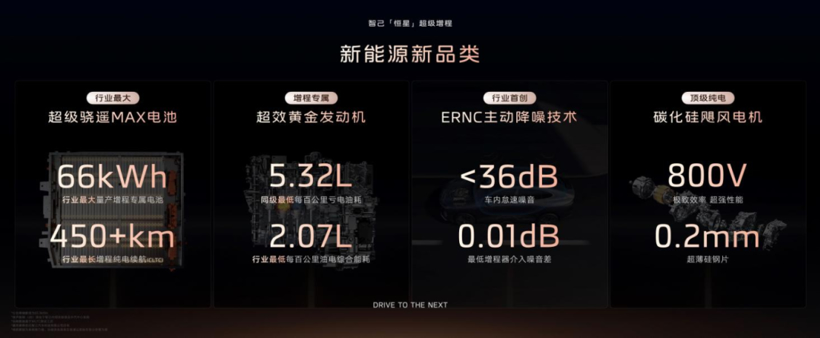Doing Range Extension May Not Necessarily Help, but Not Doing It Means Even Less Opportunity
“Range extenders have the least technical content; I’d never do range extenders.”
"Automakers that make range-extended vehicles have great sales; consumers' choices don't lie."
In recent years, people in the automotive circle around me have generally held two attitudes towards range-extended vehicles. One group scoffs at range extenders, considering them lacking in technological content and viewing the production of range-extended vehicles as a step backward for the industry. The other group holds them in high regard, believing that consumer choice is the greatest endorsement of range-extended vehicles, and that these vehicles have unlimited potential.
However, discussions aside, the sales growth of range-extended vehicles in recent years has been astonishing, showing a trend of dividing the market alongside pure electric and plug-in hybrid vehicles. Against this backdrop, Li Auto achieved annual sales exceeding 500,000 units in 2024 relying solely on the range-extended route, while Leapmotor, with its "half-price Li Auto" strategy, topped the new energy vehicle sales rankings, prompting many automakers to feel tempted and consider trying the range-extended approach.
At present, including IM Motors, which has already decided to develop range-extender vehicles, as well as Volkswagen, Toyota, and General Motors, who are rumored to be entering the field, both new and established players continue to flood into the range extender track, betting on this technology route in a gamble serious enough to be a matter of life and death.
However, outside the bustling and lively gambling tables, the lukewarm market data is quietly pouring cold water on range extenders.
Data shows that in the first half of this year, within the domestic new energy vehicle market, pure electric vehicles accounted for approximately 60.9% of the market share, plug-in hybrid vehicles accounted for about 29.3%, and extended-range vehicles accounted for around 9.8%. In 2024, the respective figures for these three categories were 57.9%, 31.4%, and 10.7%. It can be seen that among the three, only the market share of pure electric vehicles has increased, while the shares of plug-in hybrid and extended-range vehicles have both declined.
Based on this, the argument that "range extenders may not necessarily save sales" has begun to spread within the industry, and there are divergent opinions on whether "betting on range extenders is a risky gamble or a precise breakthrough." Nevertheless, this has not stopped car manufacturers from entering the range extender market. For example, IM Motors proceeded with the launch of its range extender as previously announced.
01IM Motors carves its own path
On August 1st, IM Motors launched the SAIC self-developed "Hengxing" super range-extending technology, announcing its entry into the range-extended market. From a technical perspective, IM's version of the range extender has many highlights, such as the mass-produced maximum 66kWh CATL Xiaoyao Max battery, 800V high-voltage platform, CLTC pure electric range of over 450km, a comprehensive fuel consumption of 2.07L per 100km, and a fuel consumption of 5.32L when the battery is depleted.
For newcomers, in order to stand out among a host of strong competitors, they must have their own "trump card." Especially after seeing how formidable their opponents are, they need to be well-prepared to face the challenge.
At present, those engaged in range extender technology in the market are by no means ordinary players.

Brands like Li Auto and AITO have achieved success in the extended-range electric vehicle sector. Through forward-looking insights into market demand, precise positioning, and deep collaboration in technological implementation, Li Auto’s L series and AITO’s M series have built a solid stronghold in the high-end market.
Leapmotor, known as the "half-price ideal," has made a killing in the end market with advantages such as "spaciousness and high cost performance." This not only helped Leapmotor top the new forces’ sales charts for several consecutive months—creating a legendary comeback story—but also revealed the adaptability and flexibility of range extension technology across different price segments.
Therefore, IM Motors has officially entered the range-extended vehicle market, bringing with it several industry-leading advantages such as “the longest in the industry” and “the lowest among peers” from a technical standpoint.
Among these, the CLTC pure electric range surpassing the 450km mark is currently the highest among mass-produced range-extended vehicles. This means that for most users' daily commutes (typically 30-50km per day), pure electric power alone is sufficient, making it possible to charge just once a week. This brings the usage experience infinitely close to that of a pure electric vehicle and greatly reduces users' anxiety about the "range extender starting up."
With the empowerment of the 800V high-voltage platform, not only does it lay the groundwork for future ultra-fast charging compatibility, but it also enhances overall system efficiency. Combined with a highly efficient range extender, “Stellar” achieves a comprehensive fuel consumption of 2.07L per 100 kilometers and a depleted-battery fuel consumption of 5.32L. Against the backdrop of soaring oil prices, low fuel consumption is a core selling point that appeals to pragmatic consumers and establishes the advantages of “Stellar.”

Not only that, with the launch of the "Stellar" super extended-range system, IM Motors has also completed the strategic puzzle of the dual technology routes of "pure electric + extended range." The management of IM Motors stated in an interview with the media, "Walking on two legs allows us to walk more steadily."
As stated, the incremental potential brought by the limitations of range-extending technology is exactly what IM Motors currently needs, or even urgently requires.
Based on sales figures from the first half of the year, IM Motors’ cumulative sales reached only 19,000 units (wholesale). Although this represents significant progress compared to its early days, considering the current fiercely competitive new energy vehicle market, IM Motors clearly needs greater sales growth and stronger brand awareness if it wants to move up to a higher tier of competition.
Choosing to engage in range extension is undoubtedly an opportunity.
02Is the medication effective?
Currently, as research on user profiles continues to deepen, the market space for range extenders is gradually becoming clearer.
Data analysis shows that the penetration rate of range-extended vehicles exhibits a clear differentiation across price segments. In the first quarter of this year, the penetration rate for range-extended vehicles in the 100,000-150,000 RMB price range was only 2%. The analysis also points out that as technology matures and user demand increases, the penetration rate of range-extended vehicles in the lower price segment is expected to gradually rise, and may reach 10-15% by 2027.
Meanwhile, the penetration rate of range-extended vehicles priced at 400,000 yuan and above has exceeded 30%. The underlying logic is that consumers in the mid-to-high price range are more concerned about addressing shortcomings (such as range anxiety) and have higher demands for comfort.
From the current landscape of the range-extended vehicle market, Li Auto is positioned for family use, while AITO excels in intelligence. Both have established an unbreakable stronghold in the high-end market above 400,000 yuan, becoming the top choice for affluent families. In the 100,000 to 150,000 yuan price range, Leapmotor is thriving, with models such as the C16 and C10 accounting for over 40% of its sales, continuously tapping into the huge potential of lower-tier markets.
If Zhiji wants to compete for market share, it also needs to identify its differentiating advantages. For example, technological leadership, experience assurance, design aesthetics, driving control genes, SAIC endorsement, and Zhiji Auto's proposed new category positioning of "electric vehicles with their own supercharging piles" are opportunities to shape a new extended-range image for Zhiji Auto and attract a wide range of users.
However, to what extent IM Motors can achieve with range extenders remains questionable. This is not a problem with IM Motors itself, but rather an issue faced by the current range extender market.
In April this year, China's new energy vehicle market reached a milestone: the combined sales of extended-range and plug-in hybrid models accounted for over 50% of the new energy market for the first time, becoming the core driving force for industry growth. However, behind the prosperity, the extended-range technology route holds hidden concerns—the market share has declined from 10.7% last year to 9.8% in the first half of this year, squeezed by the growth of pure electric models.
This is also why there have been increasing doubts about range extenders in the market recently.
Certainly, in the short term, the growth rate of the range-extended market is indeed slowing down, but from a long-term perspective, the different driving experiences brought by this technical route are still valued by consumers. As industry insiders have said, "The diversification of new energy technology routes reflects the law of industrial development and also means that market competition has found a way out for different technologies."
Zhiji Auto's commitment to range extenders is essentially a bet on trust. It bets that, now and for the coming years, "ultra-long pure electric range + efficient range extension" will remain the most practical solution for new energy vehicles.
IM Motors' decision to double down on the extended-range market at a time when its growth is slowing may or may not prove to be a happy ending adventure, but for now, it is certainly worth a try. For many car companies, engaging in extended-range technology may not necessarily be beneficial, but not doing so leaves even less opportunity.
【Copyright and Disclaimer】The above information is collected and organized by PlastMatch. The copyright belongs to the original author. This article is reprinted for the purpose of providing more information, and it does not imply that PlastMatch endorses the views expressed in the article or guarantees its accuracy. If there are any errors in the source attribution or if your legitimate rights have been infringed, please contact us, and we will promptly correct or remove the content. If other media, websites, or individuals use the aforementioned content, they must clearly indicate the original source and origin of the work and assume legal responsibility on their own.
Most Popular
-

List Released! Mexico Announces 50% Tariff On 1,371 China Product Categories
-

EU Changes ELV Regulation Again: Recycled Plastic Content Dispute and Exclusion of Bio-Based Plastics
-

Clariant Unveils Cost-Cutting Plan Details, Plans to Shut Down Multiple Plants
-

Mexico officially imposes tariffs on 1,400 chinese products, with rates up to 50%
-

Nissan Cuts Production of New Leaf EV in Half Due to Battery Shortage






